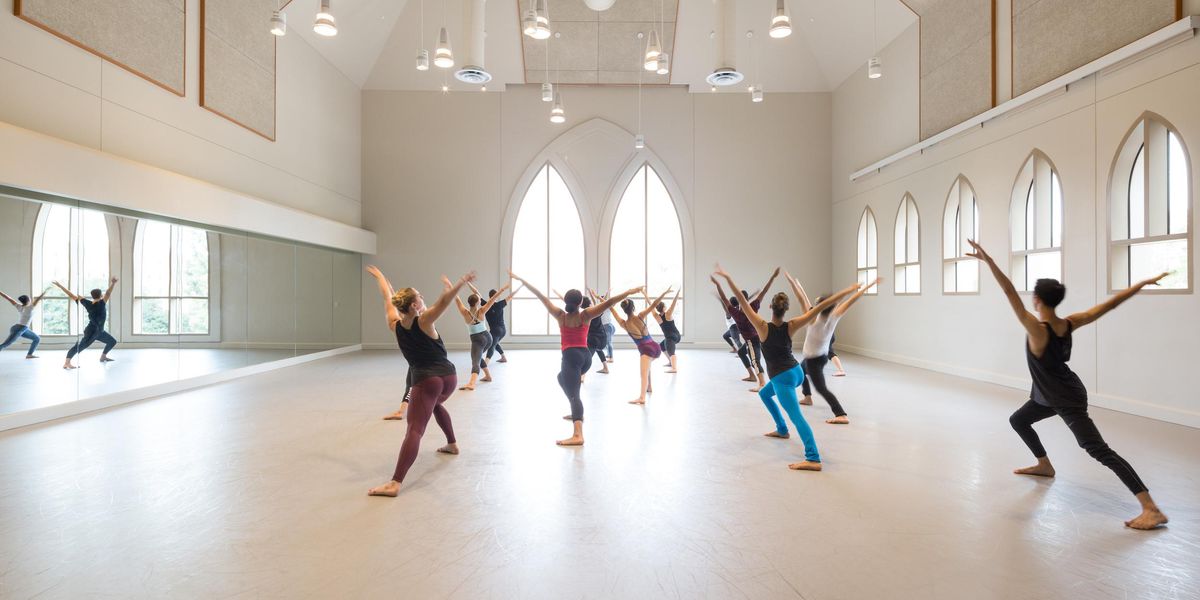Where Science and Dance Meet
Above: Studying dance science doesn’t always mean you’ll lose performance opportunities. Here, Goucher students perform in Pascal Rioult’s
Wien. Photo by Jason Lee, Courtesy Goucher.
Dance science is one of the fastest-growing areas of interest for college dance majors, and one that doesn’t necessarily mean you have to sacrifice time in the studio. A second degree or concentration in the subject opens up a variety of practical career paths. For instance, dance science students often go on to pursue graduate degrees in physical therapy, dance medicine or kinesiology. It’s also common for dancers with science backgrounds to work as teachers, personal trainers or somatic instructors while performing. Of course, dance science programs vary in terms of focus and course requirements. Here are three top options to include in your search.
GOUCHER COLLEGE
Baltimore, MD; goucher.edu
Degrees offered: BA in dance with a concentration in dance science. (A biological science major with a concentration in dance science is also offered—course requirements are very different.)
Audition required:
No
Technique classes required:
A minimum of six technique credits total; two per semester are suggested. Dance majors must also take composition, music for dance, lighting design, technical stage application, dance history, Labanotation, anatomy and kinesiology for dancers and dance criticism, theory and philosophy.
Nondance courses required:
Six credits of classes in biological diversity, cell biology and biochemistry, animal physiology, nutrition, chemistry, biochemistry, physics or introduction to psychology.
Performance opportunities:
A student must be enrolled in at least one technique class in the same semester she wishes to perform.
Opportunities for outside study:
Internships are encouraged. In the past, students have shadowed physical therapists and physicians or have worked with a foot surgeon at nearby MedStar Union Memorial Hospital.
ELON UNIVERSITY
Elon, NC; elon.edu
Degrees offered:
BS in dance science. Many BFA dance performance and choreography students choose to double-major (earning both a BFA and a BS).
Audition required:
Only the BFA program requires an audition.
Technique classes required:
One ballet, modern, jazz, tap class; two world dance classes; somatics; improvisation and choreography classes are available. Double majors take daily technique classes. Dance history is required.
Nondance courses required:
Nutrition, human anatomy, human physiology, somatic theories, biomechanics, sports psychology, physiology of exercise, research methods
Performance opportunities:
Auditions for the Elon Dance Company—which performs around three times per year—are open to dance science majors.
Opportunities for outside study:
Not required, but credit is given. Students have interned with the Harkness Center for Dance Injuries, shadowed those in Elon’s physical therapy graduate program and have conducted and presented research with Elon’s dance and exercise science faculty.
UNIVERSITY OF CALIFORNIA, IRVINE
Irvine, CA; uci.edu
Degrees offered:
BA in dance with the option to focus in dance science. (BFA dance students can also take dance science courses, though they often encounter more scheduling limitations.)
Audition required:
Yes
Technique classes required:
At least one per semester. Students typically enroll in ballet and modern classes three to five times per week.
Nondance courses required:
Dance health and injury prevention, kinesiology for dance and experiential anatomy. Students must take at least 12 units of elective classes, and by working with a faculty advisor, students can create a track for themselves, often enrolling in medical, science, sports medicine or motion-capture classes offered in departments across campus.
Performance opportunities:
Students are required to earn two performance credits from departmental concerts.
Opportunities for outside study:
While they’re not required, students can take part in short-term projects that relate to their research. Students commonly work with professors to conduct research and present at International Association for Dance Medicine & Science conferences, earn Pilates certifications or work with the physical therapist in the dance department. n




